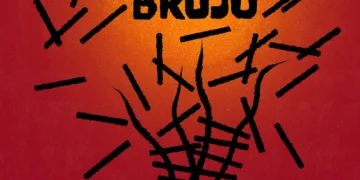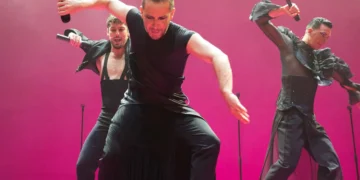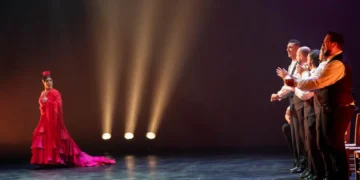|
‘EN SUS 13’ |
||
|
SPECIAL BIENAL DE FLAMENCO DE SEVILLA 2008 Text: Estela Zatania Dance, production , direction and choreography: Olga Pericet, Manuel Liñán, Marco Flores. Guest artist: Daniel Doña. Dancers: Tacha González, Ana Romero. Cante: Emilio Florido, Jesús Corbacho. Guitar and original music: Antonia Jiménez, Arcadio Martín. Percussion: Sergio Martínez. “En Sus 13” is the name of this work, and also of the new company that has been six years in gelling via a series of successful projects. Few dance companies get so much talent together in so few. The typical group revolves around a central figure, surrounded by a corps de ballet. This small group however, affords the opportunity to see three major personalities on stage, each one an experienced pro. Manuel Liñán from Granada: noteworthy and highly prized dancer and choreographer. Olga Pericet from Córdoba: well-known, versatile and accomplished. Marco Flores from Arcos: a long list of accomplishments despite his youth, and winner of the highest dance award at last year’s Córdoba contest. The three took on the chores of producing, directing and choreographing this work which is basically a reiteration of previous shows they’ve done. Robotic postures and rigorous minimalism that seeks to put order in a disorderly world full of messy emotions, is their particular approach to flamenco. A sort of anti-art that is as “modern” as Man Ray or Fritz Lang’s movie “Metropolis” made in 1926. Relentless austerity and darkness that doesn’t let up, and immunity to emotion reflect the ongoing protest of the current generation of flamenco dancers against what they consider the tawdriness associated with flamenco, specifically: polkadots, bright colors, dances with dramatic closings, furtive looks and lots of sweat. Believing one is modern is a surefire way of looking hackneyed, but this work just manages to avoid that pitfall thanks to the solo dances of the three stars where they let down their neatly-coiffed hair and allow unseemly feelings to leak out through their industrial-size personalities and an almost frightening technical command. Marco’s intense martinete, the dangerous sweetness of Olga’s alegrías with bata de cola, and Manuel’s soleá with original moves and a delightful sense of humor in the bulerías ending are the best moments. Emilio Florido is wonderful singing for the dancers, and it’s been a long time since Antonia Martínez stopped being “a woman who plays guitar” to take her rightful place within the profession. It’s possible (I cannot be absolutely sure) this work includes the first danced ‘trilla’. Also novel is the bulerías finale when the anti-polkadot feeling is given full reign with a backdrop that contains gigantic polkadots, and more that are scattered on the costumes. A sort of Stockholm complex, sleeping with the enemy or what have you, and even the dancers take it as good clean fun as they smilingly dance to a flamenco rap. This fine work would gain credibility with more moments like this.
|
Descubre más desde Revista DeFlamenco.com
Suscríbete y recibe las últimas entradas en tu correo electrónico.


 XV BIENAL DE FLAMENCO DE SEVILLA
XV BIENAL DE FLAMENCO DE SEVILLA























